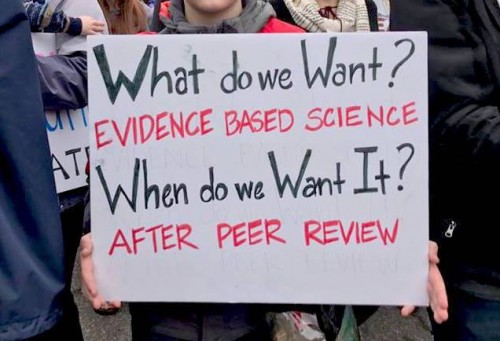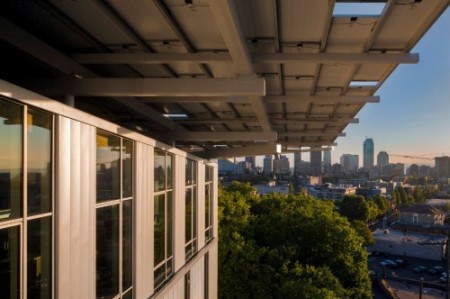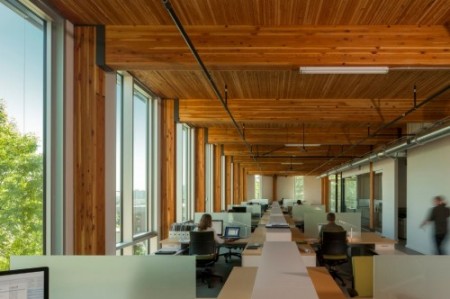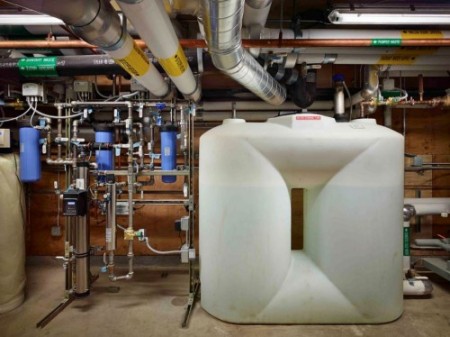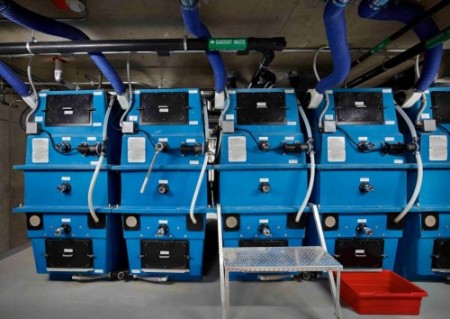Friday 19 May 2017
On 9th May I presented at the Flame Conference, Europe’s leading natural gas and LNG conference. This was a different audience for me as I don’t often present to the massed ranks of the energy supply industry. As I said during my introduction, my good news is usually their bad news. Here is a version of my presentation.
We are at the beginning of the perfect storm for energy efficiency with six major drivers all coming together. The drivers are:
- Policy
- Economics
- Finance
- Technology
- Business models
- Market infrastructure
My argument is that these drivers coming together will significantly accelerate the uptake of the energy efficiency potential and seriously dent future energy demand.
In Europe the EC released its winter package late last year which was entitled “Clean Energy for all Europeans”. Amongst its thousands of pages there were some significant proposals for energy efficiency including adopting a 30% binding energy efficiency target for 2030, a revised Energy Efficiency Directive, and a revised Directive on the Energy Performance of Buildings. We already have policies on Near Zero Energy buildings, Minimum Energy Efficiency Standards, and mandated energy audits for large organisations every four years. On top of these policies we have significant public funding going into energy efficiency as Project Development Assistance, loans and guarantees. Outside Europe, despite the best efforts of the current administration, many cities and states in the US are ramping up their energy efficiency programmes as a way of reducing environmental impacts and creating employment.
On economics, those of us who have been long-term advocates of energy efficiency have always argued that improving energy efficiency is the cheapest, (as well as quickest and cleanest) way of meeting demand for energy services. Now we have the evidence on this. The Derisking Energy Efficiency Platform (DEEP), created by the Energy Efficiency Financial Institutions Group Derisking project, has data on more than 7,500 projects across industry and buildings. The mean cost of energy efficiency for buildings is 2.5 euro cent per kWh while for industry it is 1.2 euro cent per kWh. On top of the financial benefits from energy cost savings, it is increasingly recognised that energy efficiency brings with it many non-energy benefits including amongst others; improved health and well-being, increased productivity, and increased asset value. These non-energy benefits can be much more valuable and much more strategic to decision makers than simple energy cost savings, and therefore projects sold in this way are more likely to proceed. Energy efficiency projects should and are increasingly sold on these strategic non-energy benefits.
Finance is the next driver of change. For many years energy efficiency professionals said “there is no money for efficiency”. This is no longer true. There is a wall of capital looking to invest in energy efficiency because it is low risk and offers the most impactful way to influence emissions and climate change. Groups like the Institutional Investors Group on Climate Change, which has 130 members with €18 trillion in assets, are pushing to increase the deployment of capital into energy efficiency. More than 140 banks have signed commitments to increase their deployments into efficiency. Finally the massive scale of the opportunity, perhaps the biggest money making opportunity on the planet, has been recognised. There is more money available than there are well developed projects. The issues now are all about practical ways to scale up the development and funding of energy efficiency investments.
Energy efficiency technology is moving rapidly and getting cheaper, and it is not all about LED lighting. New smart control technologies, artificial intelligence and retrofit prefabrication technologies are all getting cheaper. Innovations like Energiesprong offer rapid retrofits which can greatly improve living conditions, speed up retrofits to a week or less, and result in financed solutions that end up in a net zero energy house – something that will be deeply attractive to many consumers, particularly in markets like the UK where energy companies are deeply unpopular. The number of efficiency start-ups has increased and at the other end of the scale large companies are adapting and developing new technologies.
Along with technology and finance another important driver is business models. When people start talking about energy efficiency it does not take long for the conversation to shift to Energy Performance Contracts or EPCs. EPCs have been around a long time but remain a small market, the reason why they remain small is they don’t work in most sectors. They work in the US public sector and to a limited degree the EU public sector, but they don’t work in commercial real estate or in industry. New contract and business models are emerging such as Efficiency Service Agreements and Managed Energy Efficiency Agreements. In California and other US states there is real innovation in which energy efficiency is actually being metered just like any other energy supply. This allows several things; for the first time we can actually pay for performance rather than just pay for stuff like insulation and new boilers and hope it works, secondly efficiency can become a metered commodity and a reliable energy source like any others – something it has never been before.
On top of all these drivers we have a number of what I call market infrastructure developments. Chief amongst these is the Investor Confidence Project (ICP) which addresses one of the major barriers to scaling up investment into energy efficiency. This lack of standardisation increases performance risk, increase due diligence costs, prevents aggregation of multiple small projects and prevents banks and investors building teams around standard processes. The ICP through its Investor Ready Energy Efficiency™ provides a way of standardising through best practice, transparency and independent quality assurance.
So how far can we go in decoupling energy growth and economic growth? When I first became a student of energy in the late 1970s it was accepted that energy use and GDP were firmly coupled. All forecasts of demand were based on that idea. Then we moved to “relative decoupling” in which energy use grew less rapidly than economic output. After that came “absolute decoupling” in which energy use declines while economic output continues to grow. Since 2007/08 we seem to have entered absolute decoupling in Europe and the US.
We need to learn a lesson from history when thinking about future energy demand. In the 1970s two significant low energy scenarios were published. In 1976 Amory Lovins published “Energy strategy: the road not taken” in which he described “soft energy paths” and in 1979 Gerald Leach et.al. published “A low energy strategy for the UK”. Both of these were considered wildly optimistic at the time and widely panned by analysts, the energy industry and government agencies. History shows that they turned out to be more accurate than any official government or energy industry scenario. As I said in the title of a blog a while back; “Surprise, you are living in a low energy future”. What is more, we achieved that low energy future without really trying, except perhaps for a ten year period starting in the mid-to late 1970s.
So to answer an expanded version of the question in the title, “How much will technology / policy / economics / finance / business models and emerging market infrastructure reduce energy demand?”, a lot more than you think!
Friday 12 May 2017
On 2nd May I was fortunate enough to present at the G20 Energy Efficiency Forum and take part in a panel discussion. The G20 energy efficiency work has not got much attention but there are some good things happening and at the event the group, with 15 participating countries chaired by France and Mexico, launched its G20 Energy Efficiency Toolkit.
The toolkit offers a perspective on scaling up energy efficiency investments by defining and separating “core” EE investments – those stand-alone projects where energy savings are the main driver – and “integral” investments where overall asset performance is the lead driver but energy efficiency is delivered as one of multiple benefits over and above the main driver.
The global investment in energy efficiency has been identified by the IEA as $221bn with the US, EU and China representing 70% of the total. Within the EU 80% of the total investments were in buildings, with over 90% in Germany, UK and France. The toolkit reports that the largest “core” energy efficiency investment is in the market for Energy Performance Contracts which totalled $24 billion. I assume this means third party investment as internal balance sheet financed projects are surely much higher.
The G20 EE Toolkit offers advice to different groups including policy makers, private sector banks, institutional investors and the insurance sector. It also gives case studies from various countries including Mexico, France, China, Australia and others.
There are parallels with my energy productivity work for KAPSARC. In that I distinguished between “energy efficiency” investments and “normal investments”, a definition which parallels the G20’s “core” and “integral”. Energy efficiency investments are those where the main purpose is energy saving. This includes much of what we usually think of as energy efficiency, retrofitting buildings or production lines for example. While these are important at any one time hundreds of investment decisions are being taken on all kinds of infrastructure that will affect our energy consumption and emissions for the next twenty to fifty years or even beyond. Most of these are not “energy efficiency investments” but “normal” investments where the main purpose is not energy efficiency.
Pure energy efficiency investments can be ramped up by specialised funds or facilities and public-private partnerships with public finance providing development capital and guarantees. Any programme needs to:
- Provide finance
- Build pipelines of projects
- Build capacity in end-users, energy efficiency industry and finance industry
- Standardize development process, documentation, contracts and measurement
Encouraging the growth of the ESCO-EPC market also helps drive pure energy efficiency investments. This can be done through models like ESCO-EPC facilitation (e.g. Berlin, RE:FIT) and Super-ESCOs (e.g. Etihad).
It is also important to build market infrastructure through:
- Standardization of process (e.g. Investor Confidence Project)
- Standardization of contracts (e.g. standard EPCs)
- Standardization of Measurement & Verification
- Build evidence bases of project performance
- Build capacity within financial sector.
It is also important to continue to build demand through strong Minimum Energy Performance Standards and building capacity in energy management through standards e.g. ISO 50001
As well as ramping up pure energy efficiency or core investments we need to ensure the efficiency opportunities presented by normal investments are not being missed. Even if you design a building to code and that makes it low energy compared to existing buildings it is not really doing anything to improve the situation – I would not count it as an energy efficiency investment. It is a normal investment and a missed opportunity to include cost-effective energy efficiency measures. Every day, in design and investment decisions around the world, the economic potential to improve energy efficiency beyond business as usual is being missed. We need to change that through better regulation, capacity building amongst investors, specifiers and designers and implementing better design processes such as integrated design. Banks and investors can help this process by building in checks and questions during their investment decision making. These processes should force borrowers to review their specifications and designs. EBRD has been doing this for a long time. By doing this the banks can reduce customer risks by reducing their energy bills and increase the deployment of capital into cost-effective opportunities.
To scale up energy efficiency we need to take actions to increase the rate energy efficiency investments, and actions to increase the uptake of cost-effective efficiency opportunities within normal investments.
Monday 24 April 2017
The marches for science in many cities around the world this weekend were good to see. We often seem to be entering a world of anti-science, especially amongst the religious right in the US and the current administration. Groups like the anti-vaccination brigade and those who want to teach creation alongside evolution are bad signs of the growing power of anti-science. At the same time we are increasingly dependent on technology, much of which flows from a deep scientific understanding of the universe and how it works, at least in the little backwater that we inhabit. It is weird that the anti-science people still want benefits from science including clean water, cheaper and healthier food, medical treatment (apart from the ones they disagree with), electricity, the internet and mobile phones.
The great physicist Richard Feynman wrote an essay called “The Value of Science”. He talks about three values. Firstly the obvious one is the technology that flows from science. Technology is not always driven by science but the two things are increasingly inter-dependent. Science has allowed us to develop medicines that have eliminated diseases like polio and smallpox, it helped developed anaesthesia, it enables us to understand and harness electricity, it allowed us to develop micro-processors etc. etc. The list goes on and on. Feynman’s second value is the inspiration and enjoyment that comes from exploring the universe. Even if we personally cannot directly take part or fully comprehend much of the science it is inspiring to read and think about. Who cannot be at least a little inspired by scientists being able to decode DNA, or listening to the sound of radio signals received from pulsars by Jodrell Bank, or this picture of earth taken by the Cassini probe around Saturn? (The arrow mark earth).
The third value that Feynman identified is that science always deals with ignorance, doubt and uncertainty. He said:
“Now, we scientists… take it for granted that it is perfectly consistent to be unsure, that it is possible to live and not know. But I don’t know whether everyone realizes this is true. Our freedom to doubt was born out of a struggle against authority in the early days of science. It was a very deep and strong struggle: permitting us to question – to doubt – to not be sure. I think that it is important that we do not forget this struggle and thus perhaps lose what we have gained. Herein lies a responsibility to society.”
This is subtle but important. It is about our freedom to doubt authority. Scientists like Galileo challenged authority and science continues to do that to this day. The element of doubt Feynman refers to is so vital because the really dangerous people in the world are the anti-science people with no doubts.
Science is amazing. It is also part of what makes us human. Only a science based approach can make everyone wealthy and healthy and clean up the environment, which is what we need to do as quickly as possible. We should be massively increasing spending on science and science education not cutting it.
Sign of the day.
Friday 7 April 2017
Having written and talked about the Bullitt Center in Seattle and the Metered Energy Efficiency Transactions Structure (MEETS) which it pioneered it was great to finally visit this impressive building during my recent trip to the US. I was lucky enough to be given a personal tour by Denis Hayes, President and CEO of the Bullitt Foundation and noted environmentalist, best known as the co-ordinator of the first Earth Day in 1970 and Head of the Solar Energy Research Institute (now NREL) during the Carter administration.
The six storey, 52,000 square feet building was designed and built for the Bullitt Foundation, which exists to “to safeguard the natural environment by promoting responsible human activities and sustainable communities in the Pacific Northwest”. The Foundation needed new office accommodation and wanted something more appropriate to its mission than its old offices in a historic building.
The decision was taken to build a cutting edge sustainable building that would both house the foundation but also serve as a commercial building. When talking to designers and leading green developers the foundation team were told that their aspirations of a net energy positive, sustainable building for the same (or less) cost than a normal class A building was impossible. Having been told it was impossible the foundation persevered and achieved all their goals. After reviewing different green building standards Denis Hayes settled on using the Living Building Challenge. To fulfill the requirements of the Living Building Challenge a building must demonstrate 12 months of operational performance according to 20 Imperatives distributed amongst seven “petals”: Site, Water, Energy, Health, Materials, Equity, and Beauty.
On energy the design called for net energy positive and an Energy Use Intensity (EUI) of 16 (measured in the quaint US units of kBtu/square feet/year), equivalent to the output of the 244 kW rooftop PV installation. This should be compared to the following EUI benchmarks:
- average for all Seattle office buildings: 92
- Seattle energy code building: 50
- Medium Office designed to ASHRAE 90.1 – 2007 (all climates): 47.7
- LEED Platinum building: 34.
When the building was commissioned the EUI was certified as 12.3, a 74.2% saving from the ASHRAE Medium Office benchmark. With the building 85% occupied the actual EUI is 10.
Much effort was put into the glazing and lighting design with the aim of maximizing the use of daylight. On average the building is 40% glazed with the main daylighting facades having 60% glazing. The triple paned argon filled, low-E glass windows are in vertical strips to maximize daylight. External shades keep out excessive solar gain and at night the windows can open to allow warm air out. A ground source heat pump system delivers heat and occasional additional cooling on the rare hot days in Seattle.
On water the target was simple – net zero water. Despite Seattle’s reputation as being the wettest place in the US it’s average-annual rainfall is less than several other major cities. Beneath the PV array a membrane roof takes rain water to drains that flow into a 56,000 gallon cistern in the basement.
Rainwater from the cistern is pumped through several increasingly fine filters and then exposed to UV light before passing to showers and taps. Interestingly, beyond the technical difficulties, the water system faced bureaucratic and legal issues. The building had to be established and regulated as an independent water system separate from, but surrounded by the City of Seattle’s municipal water system. Grey water is treated by filters and a green roof. Perhaps the most challenging aspect of the water system is the use of composting toilets with on-site black water treatment.
The health petal was addressed by avoiding paints with Volatile Organic Compounds, including biophilic elements, and utilizing radiant floor slabs for heating and cooling.
The materials petal started with wanting to avoid the Red List, a listing of fourteen categories of materials that the International Living Future Institute prohibits in any Living Building. To help meet this goal the number of materials to be used was minimized but it still took two years to research, co-ordinate and source materials. The building sits on a concrete base but above the third floor all framing is from heavy timber 100% certified by the Forest Stewardship Council, (as is all wood in the building). Concrete formwork used salvaged plywood and plastic tree fencing, which is used to protect trees during construction, utilized fencing used on other nearby projects rather than new plastic netting shipped from China. The Living Building Challenge imposes strict requirements on the distance different materials are allowed to travel to get to the project site, requirements that the Bullitt Center met.
The Bullitt Center integrated approach to addressing the Living Building Challenge is both technically and aesthetically attractive. It is nearly fully leased to a range of tenants including an engineering firm, a technology company amongst others – proving the economic argument as well as the environmental arguments. It is a truly a landmark project and a great example of what can be done with a highly motivated client and a design team truly prepared to truly push the envelope.
Thanks to Rob Harmon of the MEETS Coalition and Denis Hayes of the Bullitt Foundation for taking the time to show me the building. You can check out the performance of the Bullitt Center at: http://buildingdashboard.com/clients/bullittcenter/
Tuesday 14 March 2017
The level of investment in energy efficiency required to meet climate and energy security targets is significantly higher than both the current levels, and the levels that can be financed by public capital. In order to scale up energy efficiency to the levels that we know are possible, and we know are needed, we need to change the game and make energy efficiency into something that people want to buy, and something that can be easily financed by institutional capital at scale.
The barriers to scaling up investment into energy efficiency are now well documented. To name just a few: projects are small, the methods of developing and documenting project development are not standardised, capacity within the financial sector to understand value and risks of energy efficiency is limited, and traditional business models such as Energy Performance Contracts are not attractive in many segments of the market. As Michael Eckhart of Citi said; “energy efficiency does not meet the needs of the capital markets”.
There are signs, however, that the foundations of a functioning energy efficiency financing market are now being put in place. The Investor Confidence Project is rolling out its Investor Ready Energy Efficiency™ project certification system in the US and Europe, with growing interest from India, China and Australia and New Zealand. The EU’s Energy Efficiency Financial Institutions Group (EEGIG) is soon to launch its “Value and risk appraisal framework for energy efficiency finance and investments”, a guide to under-writing energy efficiency projects in buildings and industry. Investors and lenders are expressing more interest in developing energy efficiency related products. In the US Property Assessed Clean Energy (PACE) continues to grow and PACE loans are now regularly being securitised.
To build upon these foundations we need to ensure that four components are brought together in the same place at the same time by entrepreneurial individuals and organisations. The four components are; finance (for projects and development), standardisation, large-scale pipelines, and capacity building on the demand side, the supply side and within the financial sector. Project finance is abundantly available and much of it is seeking environmentally conscious or green homes – the issue right now is a lack of projects. Many failed energy efficiency finance schemes prove that project finance alone is not enough.
There is a need to finance the development of projects, that risky stage between “here is a good project idea” and “here is a fully developed bankable project”. Development capital is always high risk and there is an argument for using public capital to support this stage, although of course this does not generally happen in other sectors like property or power generation so it is questionable why it should in energy efficiency. The efficiency sector generally lacks a development mentality and eco-system and so public capital could be used to kick-start the development market using low cost convertible loans or grants such as the EU’s Project Development Assistance.
Standardisation in the development and documentation of projects is now available through the Investor Confidence Project. Currently available for buildings in the US, Canada and across all countries of Europe, the Investor Ready Energy Efficiency™ project certification system is there to be used. As it brings reduced due diligence costs and greater certainty of outcome, project developers, clients and financiers will increasingly require its use.
There is a lack of large-scale pipelines that can attract institutional capital. Energy efficiency projects tend to be developed on a building by building or site by site basis rather than across portfolios. In the 1980s and early 1990s large scale energy management programmes were implemented across many public and private sector portfolios but that skill and activity seems to have been lost. We are still in the pilot project mentality all too often. To develop large pipelines requires several things. Firstly it needs entrepreneurial efforts to acquire and build pipelines. Secondly, it needs attractive and simple business models that really make sense for clients. Existing models such as Energy Performance Contracts do not make sense for large parts of the market. Emerging models such as Efficiency Services Agreements, metered efficiency and Pay for Performance are more attractive and need to be developed and deployed. Finally, it needs strong leadership from client organisations and those that convene portfolio holders such as central, city and local governments to demand effective action at scale.
Capacity building amongst clients – the demand side – needs to focus on the energy and non-energy benefits of improved energy efficiency and the availability of financed solutions. Non-energy benefits such as increased asset value or improved health and well-being need to be stressed above just energy costs savings as they are usually much more interesting and strategic to most organisations. On the supply side capacity building needs to focus on developing standardised and bankable projects with consistent results. Within the financial industry capacity building needs to be focused on understanding the nature of efficiency, understanding the sources of value and the risks, as well as on the different ways that energy efficiency can be made into a financeable asset – all subjects covered in the EEFIG under-writing guide.
Pulling these four components together requires entrepreneurial effort – effort that can come from the public and/or private sectors – and can manifest itself in different organisational forms. Successful organisational forms include, but are not limited to, procurement frameworks, super ESCOs and retrofit accelerators. Successful procurement frameworks that can be used as models include the UK’s Carbon and Energy Fund which develops and helps finance large scale projects within the National Health Service. Through its framework it delivers finance, the pipeline, capacity building and standardisation (based on the Investor Confidence Project’s system). In the US there are several retrofit accelerators which bring together the different elements. In Dubai and India there are Super-ESCos, Etihad in Dubai and EESL in India. Both have successfully brought the four components together to deliver large-scale energy efficiency programmes and are good models for Europe and the US.
Massively scaling up investment into energy efficiency remains one of the biggest financial opportunities on the planet as well as the best opportunity to improve environmental conditions and reduce the threat from climate change. Even at current low energy prices the world spends some USD 5-6 trillion a year on energy. Entrepreneurs need to work to deliver new localised and national organisational forms that bring together the four components and deliver investment projects that significantly reduce energy spend, and bring multiple other benefits.
Dr Steven Fawkes
Welcome to my blog on energy efficiency and energy efficiency financing. The first question people ask is why my blog is called 'only eleven percent' - the answer is here. I look forward to engaging with you!
Tag cloud
Black & Veatch Building technologies Caludie Haignere China Climate co-benefits David Cameron E.On EDF EDF Pulse awards Emissions Energy Energy Bill Energy Efficiency Energy Efficiency Mission energy security Environment Europe FERC Finance Fusion Government Henri Proglio innovation Innovation Gateway investment in energy Investor Confidence Project Investors Jevons paradox M&V Management net zero new technology NorthWestern Energy Stakeholders Nuclear Prime Minister RBS renewables Research survey Technology uk energy policy US USA Wind farmsMy latest entries
- A look back at the last forty years of the energy transition and a look forward to the next forty years
- Domains of Power
- Ethical AI: or ‘Open the Pod Bay Doors HAL’
- ‘This is not the end. It is not even the beginning of the end. But it is, perhaps, the end of the beginning’
- You ain’t seen nothing yet
- Are energy engineers fighting the last war?
- Book review: ‘Stellar’ by James Arbib and Tony Seba

